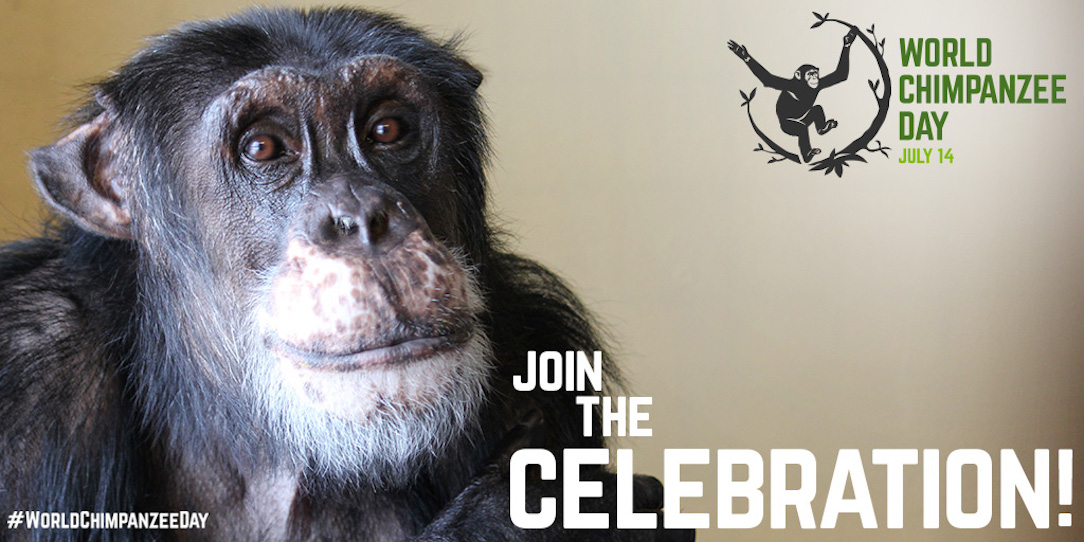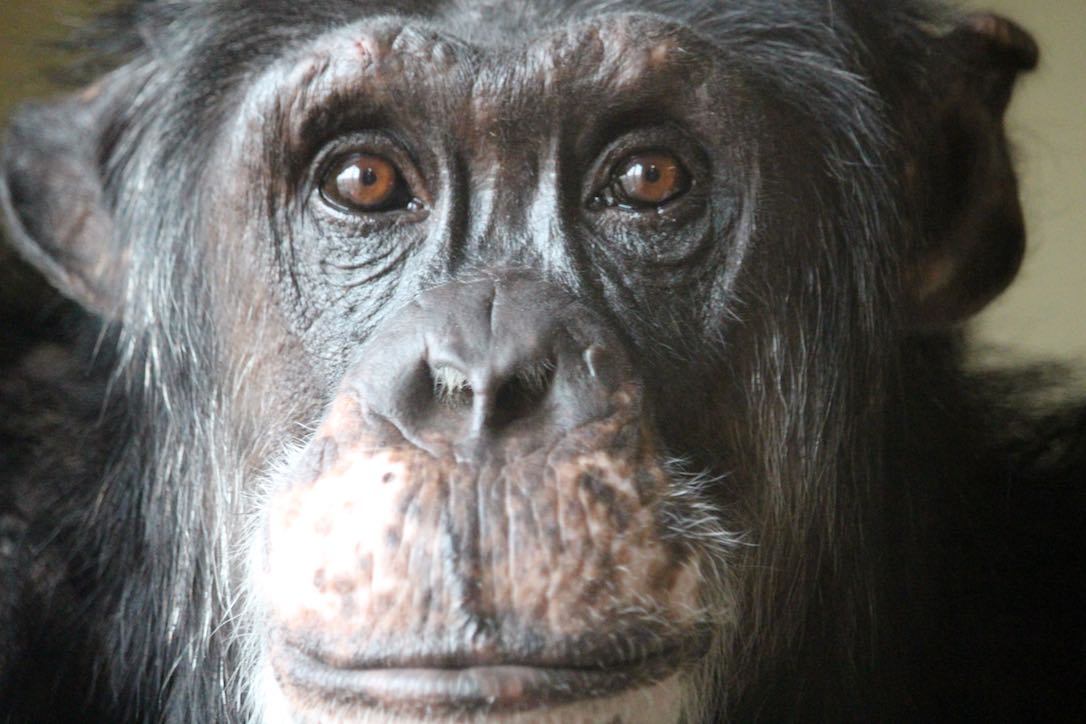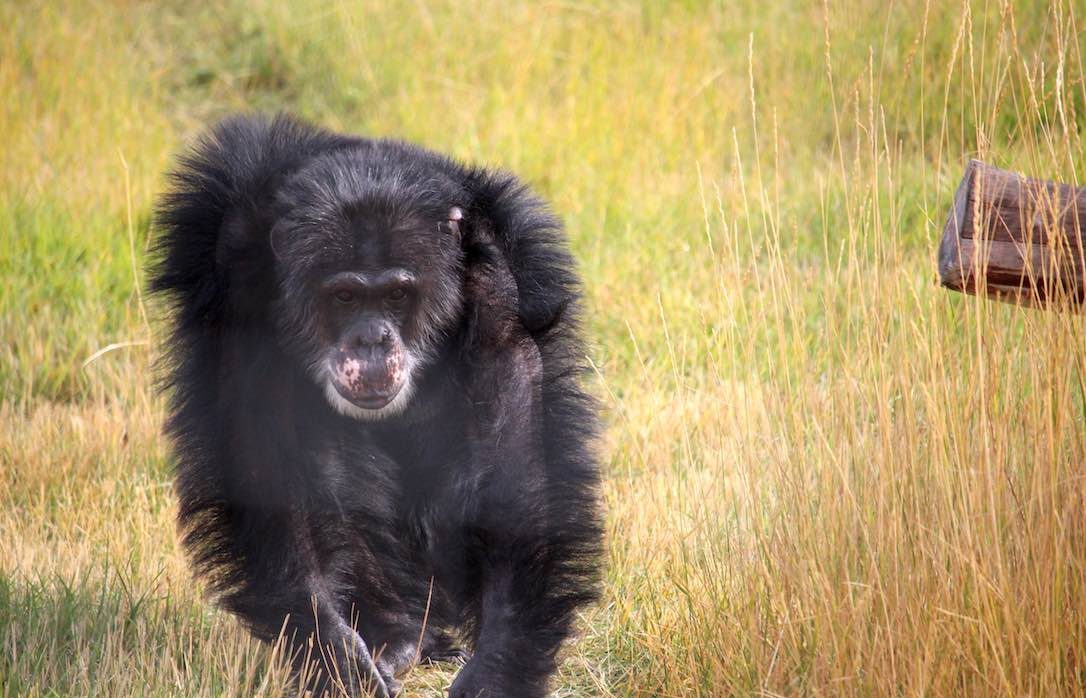
Today is the first #WorldChimpanzeeDay, a day to celebrate our closest living evolutionary cousins and an opportunity to raise awareness about the vital need for worldwide participation in their care, protection, and conservation in the wild and in the captivity.
So, in addition to celebrating the seven chimpanzees at CSNW, as we do everyday, I would like to share my personal evolution of knowledge and understanding about chimpanzees in captivity. For as long as I can remember, I’ve been fascinated by and drawn to all of the great apes. In college, I had a shrine of sorts on my wall with photos of gorillas, orangutans, and chimpanzees. One of the photos I had was a postcard of a chimpanzee who was probably four years old, wearing clothing and balancing on a tightrope. I thought it was adorable.
A few years later, I pursued my interest in great apes and ended up at Central Washington University’s Chimpanzee and Human Communication Institute. The head of the program, Dr. Roger Fouts, had recently published a book called Next of Kin, which expanded my view of chimpanzees and, for the first time, made me really think about the plight of chimpanzees in captivity and my own unquestioning amusement and delight when I saw photos of chimpanzees dressed in clothing or performing in some way.
Sitting face to face with a chimpanzee (with a safe barrier in between) was an even more powerful and humbling experience. It was immediately evident that chimpanzees have a keen sense of autonomy. They are incredibly smart and social and they have their own interests and desires.
Then I began to learn more about who they were as a species and came to the conclusion that literally no captive situation can provide chimpanzees with the socially and emotionally rich environment they would experience in the wild in Africa. The only reason there are so many chimpanzees in captivity now is because humans desired to put them there. No chimpanzee has ever volunteered to be torn from their family and forced to serve whatever purpose humans had in mind.
I share this personal experience of my own rather slow revelations because I understand both what draws people in when they see images of baby chimpanzees and how a little bit of knowledge can transform that initial “awww” reaction into a series of questions that includes: “Where is that chimpanzee’s mother?”, Where is the chimp living? (sanctuary, zoo, in the wild, in a human home)”, and “Is she or he doing something on command for the camera?”.
Sometimes it’s not possible to get immediate answers to these questions, and I’ve learned it’s important not to assume that a news organization or someone posting on social media is providing accurate information.
That brings me to a video of a young chimpanzee supposedly being reunited with a human couple that he had known as an infant. This video went viral last week and was shared on numerous national television news channels and/or their corresponding online sites, including Anderson Cooper and the Today Show, as well as dozens of local stations. I get it. The video is heartwarming and makes you want to share this “feel good” moment. But when you start to ask those questions about this video, you’ll quickly see that the chimpanzee, Limbani, was not “rescued” as those sharing the video claim. He is not living in a sanctuary, he is not living with other chimpanzees, and we don’t know where his mother is (we’ve asked). He’s living with humans 24/7 who put clothing on him and make money by having people pay to have their photo taken with him.
Limbani is living at the Zoological Wildlife Foundation (ZWF), a name that might make you think it’s a nonprofit organization with laudable aspirations. This is far from the truth. They confirmed with us that they are a for-profit business. Anyone can pay $200 to spend two minutes in a hands-on encounter with Limbani. For $700 people can spend ten minutes with this baby chimpanzee. Limbani is one of many exotic animals they have available for these “pay to play” encounters – they have the price schedule and the animals laid out very clearly on their website. Most of the animals are babies, of course, which means they are breeding more and more exotic animals into a lifetime of captivity. This is very similar to an organization called The Institute for Greatly Endangered and Rare Species (TIGERS). You’ve probably seen their videos and photos of an orangutan with a dog and a baby chimpanzee with a baby white tiger.
ZWF claims that their desire is to educate the public and help conserve endangered species. They even take donations directly from their website, which is confusing because they are not themselves a nonprofit. As a nonprofit, Chimpanzee Sanctuary Northwest is a public organization, our financial records must be publicly available, and we are obligated to spend funds towards our mission. If we are not following the rules or if a donor feels we’ve misused their money, they can appeal to the government to investigate. We are also accredited by the Global Federation of Animal Sanctuaries. The money that is given to ZWF can be spent however they like and there is no transparency or oversight required.
It’s up to everyone to speak out about this. Just like individual views like my own, societal views on animals are evolving. Most people in the US no longer find it acceptable that whales and dolphins are kept in aquariums where they perform for crowds of people (did you know it’s also World Orca Day!). The Ringling Brothers stopped using elephants in their circuses because the public became educated about the sad lives the elephants in traveling shows led. It’s beyond time for chimpanzees like Limbani to be given the same consideration.
You can spread the word whenever you see videos and photos of chimpanzees. First, ask some questions and try to get the facts of how the chimpanzee is living. Then share the facts with anyone passing along the exploitative images, including the media outlets and your friends and family.
Read about roadside zoos on our website to learn how to spot these pseudo-sanctuaries that are attempting to pose as conservation organizations or actual sanctuaries.
The North American Primate Sanctuary Alliance put out an excellent letter about this latest video of Limbani (it’s not the first video of Limbani that’s gone viral), which you can read and download here on the NAPSA website. The Dodo also published a story about the video this morning. You might want to use the hashtag #whereslimbanismom when posting about this video. We asked ZWF on instragram repeatedly about his mom and they only responded by saying that she lived in a “private sanctuary.”
Please educate others and share information in a polite way – you just never know who will be ready to have their heart opened, and opening hearts leads to changing minds.
Burrito, who was raised a pet for a year, then spent two years with a trainer before being sold into biomedical research, thanks you.







Diana,
Excellent commentary about Chimp abuse and specifically Limbani. I’ve seen the viral video and was sucked in till I researched him on Google and saw where he lived. They are making a ton of money off him and he can’t be a real chimp, sadly. How can people help besides trying to enlighten people? It’s frustrating to see these things happening and feel helpless to change it. Thanks for all you do for our fabulous 7!
Lois Gordon
Medford, Ma.
Thank you Diana
Thank you for this!
wow–what an informative and enlightening piece. I saw that
touching video too and fell for the “aw-www moment” never knowing that poor animal was being used for that purpose. I hope everyone who has read your post will pass it on and pass the word about the deceit that is being issued by false information for profit of a cptie animals
Well done, NAPSA, for the well informed letter to Anderson Cooper, and all Public Broadcast systems. Setting the public straight to the erroneous operations like TIGERS and ZWF is a foot forward to ending this places and the misconception of Primates make great pets!!! We shouldnt be surprised when Anderson Cooper will address this on HIS show, as well as TODAY. He is a “Dudley Do’right” for all that is inhumane, especially Animal Rights!! Thank you, CSNW for being the voice for your beautiful 7 charges, and Ellie too! Lol
Peace, love and the Chimptrain!!
Excellent post Dianna! Well done, and so important for all of us to hear your experienced voice speaking up on behalf of chimpanzees everywhere. Thank you Jane Goodall for (well for being Jane!) making this day a reality for people, sanctuaries, and primates everywhere. Education and awareness are powerful tools, but our individual voices are powerful tools as well.
We can make a difference for Chimpanzees (and many animals) with small acts. Such as not sharing certain posts without asking ourselves about the animal in the image. I work in animal welfare and the first question I always ask is “Are we doing everything possible to ensure we are putting the best interests of the animal first?” And I carry the voice of Jeremey Bentham in my head and heart telling me “The question is not, Can they reason? nor, Can they talk? but, Can they suffer?”
I worked in the Greeting Card Industry for a decade so I fight for the day we will no longer see chimpanzees, with their fear grimaces, on the front of greeting cards (disclaimer! I never, ever worked for a company who used chimpanzees). These images of chimps hamming it up for the camera are not cute or funny. “Best interest of the chimp”? NO! “Can they suffer?” In the hands of the trainers, YES indeed they suffer. The designers and manufacturers of these greeting cards can easily use a custom illustration in place of a photograph of a real chimpanzee. By not purchasing cards that exploit chimpanzees, we make a difference. By writing letters when we are faced with wrong doing and/or cruelty, we make a difference. Together, speaking up for our chimpanzee friends, we will make a difference and one day put an end to this cruel and distorted image of chimps as actors, props, jesters, gags, or a body to be left behind in a laboratory to “age in place” instead of being retired to an accredited sanctuary.
On this same note, I miss CSNW Eyes On Apes posts. : ) I am so very grateful to you for all you do, and for all you will be doing in the very near future. Because CSNW fights so hard for LOVE, HOME, SANCTUARY, you give me HOPE. Thank you from the bottom of my heart……
In response to Kathleen’s great comments…..it’s a small thing, but I go into stores (cvs, riteaid, walgreens, etc.) and if I see a chimp greeting card (occasionally) I hide it where hopefully no one will find it and be unable to purchase it. Makes me feel better for a few minutes!
You all are so creative! Love it when Jamie improves her perspective on the tube. 🙂
I’m not sure who’s smarter, you creative caregivers or Jamie. Your enrichment calendars are incredible. Jamie with the frozen fruit is too much! She lives up to her genius reputation however by holding onto that tube with her hot little hand, even on her patrol! Best way to create a fruity thaw for sure. Jamie never ceases to totally amaze (and amuse) me.
Hi Diana,
Thank yo so much for taking the time to write this phenomenal, heartfelt letter.
I’ve fallen in love with all of these chimps and your goals to keep them safe and loved.
I read the blogs daily and have learned so much about the chimps but also about the plight of so many others that are still in captivity and used for profit. I’ve been wanting to do something other than just read the blogs and wish I was there.
So, for now, I’m trying to help raise awareness and have added a donate button to my Facebook page.
I would also like to know what else I can do to help the sanctuary and raise awareness! I’m so in.